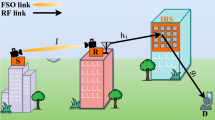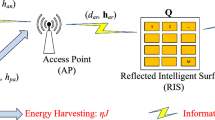Abstract
In this paper, we investigate the effect of multipath fading on the combined signal-to-noise ratio (SNR) in conjunction with multiband orthogonal frequency division multiplexing ultra-wideband system with different diversity schemes such as maximal ratio combining, equal gain combining and selection combining. In particular, we derived the probability density function of the combiner output SNR followed by performance measures, average combined SNR, outage probability and average bit error rate, in the case of L-fold log-normal fading channels. The derived mathematical expressions are illustrated by applying the method to some selected numerical examples of interest showing the impact of fading variance as-well-as a number of diversity paths, which is combined, on the performance metrics of combiner output for above diversity techniques. The results show that the number of diversity paths significantly improve the effect of multipath fading on derived performance measures.










Similar content being viewed by others
References
Abou-Rjeily, C., & Bkassiny, M. (2010). On the achievable diversity orders over non-severely faded lognormal channels. IEEE Communications Letters, 14(8), 695–697.
Alouini, M. S., & Simon, M. K. (2001). Performance analysis of coherent equal gain combining over Nakagami-m fading channels. IEEE Transactions on Vehicular Technology, 50(6), 1449–1463.
Alouini, M. S., & Simon, M. K. (2002). Dual diversity over correlated log-normal fading channels. IEEE Transactions on Communications, 50(12), 1946–1959.
Annamalai, A., & Tellambura, C. (2001). Error rates for Nakagami-m fading multichannel reception of binary and M-ary signals. IEEE Transactions on Communications, 49(1), 58–68.
Annamalai, A., Tellambura, C., & Bhargava, V. (2005). A general method for calculating error probabilities over fading channels. IEEE Transactions on Communications, 53(5), 841–852.
Batra, A., Balakrishnan, J., Aiello, G., Foerster, J., & Dabak, A. (2004). Design of a multiband OFDM system for realistic UWB channel environments. IEEE Transactions on Microwave Theory and Techniques, 52(9), 2123–2138.
Beaulieu, N. C. (2013). A novel generalized framework for performance analysis of selection combining diversity. IEEE Transactions on Communications, 61(10), 4196–4205.
Beaulieu, N. C., & Rajwani, F. (2004). Highly accurate simple closed-form approximations to lognormal sum distributions and densities. IEEE Communications Letters, 8(12), 709–711.
Beaulieu, N. C., & Xie, Q. (2004). An optimal lognormal approximation to lognormal sum distributions. IEEE Transactions on Vehicular Technology, 53(2), 479–489.
da Silva, C. R. C. M., & Yacoub, M. D. (2002). A generalized solution for diversity combining techniques in fading channels. IEEE Transactions on Microwave Theory and Techniques, 50(1), 46–50.
David Tse, P. V. (2005). Fundamentals of wireless communication. Cambridge: Cambridge University Press.
ECMA-368: High rate ultra wideband PHY and MAC standerd. Tech. rep. (2007). https://www.ecma-international.org/publications/standards/Ecma-368.htm.
Goldsmith, A. (2005). Wireless Communications. Cambridge: Cambridge University Press.
Hwang, T., Yang, C., Wu, G., Li, S., & Li, G. Y. (2009). OFDM and its wireless applications: A survey. IEEE Transactions on Vehicular Technology, 58(4), 1673–1694.
Kim, Y. G., & Beaulieu, N. C. (2010). A note on error rates for nakagami-m fading multichannel reception of binary and M-ary signals. IEEE Transactions on Communications, 58(9), 2471–2471.
Ko, Y. C., Alouini, M. S., & Simon, M. K. (2000). Average SNR of dual selection combining over correlated Nakagami-m fading channels. IEEE Communications Letters, 4(1), 12–14.
Kondoju, S. K., & Mani, V. V. (2016). Outage and average BER analysis of multiband OFDM UWB system with MRC/EGC receiver in log-normal fading channels. In: 2016 23rd International Conference on Telecommunications (ICT) (pp. 1–5).
Laourine, A., Stephenne, A., & Affes, S. (2009). On the capacity of log-normal fading channels. IEEE Transactions on Communications, 57(6), 1603–1607.
Liu, Z., Almhana, J., & McGorman, R. (2008). Approximating lognormal sum distributions with power lognormal distributions. IEEE Transactions on Vehicular Technology, 57(4), 2611–2617.
Liu, Z., Almhana, J., Wang, F., & Mcgorman, R. (2007). Mixture lognormal approximations to lognormal sum distributions. IEEE Communications Letters, 11(9), 711–713.
Lu, H., Xu, T., Nikookar, H., & Ligthart, L. P. (2013). Performance analysis of the cooperative ZP-OFDM: Diversity, capacity and complexity. Wireless Personal Communications, 68, 587–608.
Manimegalai, C. T., & Kumar, R. (2015). Performance enhancement of multi band-OFDM based ultra wide band systems for WPAN. Wireless Personal Communications, 82, 183–200.
Marinova, M., Thielens, A., Tanghe, E., Vallozzi, L., Vermeeren, G., Joseph, W., et al. (2015). Diversity performance of off-body MB-OFDM UWB-MIMO. IEEE Transactions on Antennas and Propagation, 63(7), 3187–3197.
Mehbodniya, A., & Aissa, S. (2011). Outage and BER analysis for ultrawideband-based WPAN in Nakagami-m fading channels. IEEE Transactions on Vehicular Technology, 60(7), 3515–3520.
Mehta, N. B., Wu, J., Molisch, A. F., & Zhang, J. (2007). Approximating a sum of random variables with a lognormal. IEEE Transactions on Wireless Communications, 6(7), 2690–2699.
Milton Abramowitz, I. A. S. (1970). Handbook of mathematical functions: With formulas, graphs, and mathematical tables. Gaithersburg: National Bureau of Standards.
Nouri, H., Touati, F., & Uysal, M. (2016). Diversity-multiplexing tradeoff for log-normal fading channels. IEEE Transactions on Communications, 64(7), 3119–3129.
Prasad, R. (2004). OFDM for wireless communications systems. Norwood: Artech House.
Proakis, J. (2000). Digital communications (4th ed.). New York: McGraw-Hill Engineering.
Qi, X., Alouini, M. S., & Ko, Y. C. (2003). Closed-form analysis of dual-diversity equal-gain combining over Rayleigh fading channels. IEEE Transactions on Wireless Communications, 2(6), 1120–1125.
Rahayu, Y., Rahman, T., Ngah, R., & Hall, P. (2008) Ultra wideband technology and its applications. In: Wireless and optical communications networks, 2008. 5th IFIP international conference on WOCN ’08 (pp. 1–5).
Rana, V., Chauhan, P. S., Soni, S. K., & Bhatt, M. (2017). A new closed-form of ASEP and channel capacity with MRC and selection combining over inverse gaussian shadowing. AEU—International Journal of Electronics and Communications, 74, 107–115.
Sarkar, M. Z. I., & Ratnarajah, T. (2013). Secrecy capacity over log-normal fading channel with diversity combining techniques. In: 2013 IEEE wireless communications and networking conference (WCNC) (pp. 2457–2461).
Simon, M. K., & Alouini, M. S. (2004). Digital communication over fading channels, 2 edn. Wiley series in telecommunications and signal processing. Hoboken: Wiley.
Skraparlis, D., Sandell, M., Sakarellos, V. K., Panagopoulos, A. D., & Kanellopoulos, J. D. (2010). On the effect of correlation on the performance of dual diversity receivers in lognormal fading. IEEE Communications Letters, 14(11), 1038–1040.
Snow, C., Lampe, L., & Schober, R. (2005). Performance analysis of multiband OFDM for UWB communication. In IEEE International Conference on Communications, 2005. ICC 2005 (vol. 4, pp. 2573–2578).
Sudjai, M., & Tran, L. C. (2014). A BER based adaptive STFC MB-OFDM UWB system for WBAN applications. In: 2014 IEEE international conference on communications (ICC) (pp. 5670–5675).
Yang, Q., & Kwak, K. S. (2009). Outage performance of STBC MB-OFDM UWB. AEU—International Journal of Electronics and Communications, 63(8), 685–688.
Author information
Authors and Affiliations
Corresponding author
Additional information
Publisher's Note
Springer Nature remains neutral with regard to jurisdictional claims in published maps and institutional affiliations.
Appendix
Appendix
1.1 Mean and Variance Calculations
Consider \(\gamma\) as a log-normal random variable with PDF given in (4), i.e. \(10~{\text {log}}~\gamma \approx {\mathcal {N}}\left( \mu ,\Omega \right)\). The expectation value of \(\sqrt{\gamma }\) is
The expectation value of \(\gamma\) is
and the expectation value of \(\gamma ^{2}\) is
Thus variance of \(\sqrt{\gamma }\) is
and variance of \(\gamma\) is
Rights and permissions
About this article
Cite this article
Kondoju, S.K., Vakamulla, V.M. Closed-Form Analysis of Various Diversity Techniques for Multiband OFDM UWB System Over Log-Normal Fading Channels. Wireless Pers Commun 109, 1781–1803 (2019). https://doi.org/10.1007/s11277-019-06652-z
Published:
Issue Date:
DOI: https://doi.org/10.1007/s11277-019-06652-z




